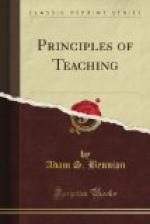OUTLINE—CHAPTER XXI
Taking Stock.—Miss Stevens’ study on questioning.—Miss Stevens quoted.—Various types of questions: a. The review question; b. The fact question; c. The leading question; d. The thought or challenging question.—Some questions on questioning.
How many questions do you ask regularly during a recitation?
What proportion of those questions are answered in full and complete statements?
How many of the answers to your questions are a matter merely of memory? How many reveal original, creative thinking?
Such questions as these not only impress us with the force of the question as a means of teaching, but they lead us to examine into our own method of asking them. The whole teaching process so easily and unconsciously develops into a matter of routine that it is good practice occasionally to take stock of ourselves. It is surprising to find how many teachers develop a particular type of question which becomes their sole stock in trade.
Miss Ronniett Stevens, in her thesis, The Question as a Measure of Efficiency in Instruction, has made one of the most enlightening studies yet made on the matter of questioning. Her results are quoted by Weigle, in his Talks to Sunday School Teachers, in a passage of interest, not only because of Miss Stevens’ findings, but also because of Mr. Weigle’s own conclusions:
“One of the outstanding differences, in present practice, between the public and the Sunday school, is that most public school teachers ask too many questions and most Sunday school teachers do not ask questions enough. For the first half of this statement there is ample evidence in the careful study by Miss Ronniett Stevens on The Question as a Measure of Efficiency in Instruction. Miss Stevens secured complete stenographic reports of twenty high school lessons in English, history, science, Latin, modern languages, and mathematics; she observed one hundred more such lessons chosen at random, with a view to counting and noting the number and nature of the questions asked in each; and she followed each ten classes through an entire day’s work for the purpose of studying the aggregate question-stimulus to which each was subjected in the course of the day.
“The results of her study are surprising. In only eight of the twenty lessons completely reported the teacher asked less than ninety questions in the period of forty-five minutes, the average being sixty-eight. In each of the remaining twelve lessons more than ninety questions were asked in the same period of time, the average being 128. A freshman class in high school, in a day’s work of five periods of forty minutes each, not counting gymnasium, was subjected to 516 questions and expected to return 516 answers, which is at the rate of 2:58 questions and 2:58 answers per minute. The lowest number of questions recorded in a day’s work




